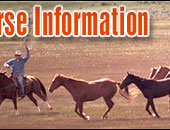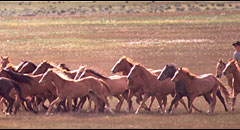 |
   |
|
|
|
You are here: Horses > Horse pasture / forage > Forage foundations |
Great Tips for Healthy Forage
Your pasture is a source for serious nutrition if you plan and maintain it
properly. Generally speaking, you will need to allocate two to four acres per
animal, but occasionally you can get away with a smaller pasture if you use it
for limited grazing. Some horse owners will divide their pastures into paddocks
to increase the health and maximize the amount of the forage.
|
|
|
To ensure that your pasture contains good forage, rely on
the species that are native to your area, since your climate
and soil will support them best. Kentucky bluegrass,
ryegrass, tall fescue and also orchardgrass are popular cool
season grasses which should be mixed with some white clover
seeds. The clover is important since it elevated protein
levels and also adds nitrogen for the soil. If you live in a
warm area, you will want to rely on warm season grass, such
as Bermuda grass. While it is true that you do not need to
seed your cool season grass until the late summer or early
fall, it is never too early to plan for your next reseeding
session.
|
Here is a list of grasses that are both liked for their nutritional values
but also for their palatability:
- Orchardgrass is a forage of choice that may grow anywhere in the United
States. It will do better in the heartland and the northern portion of the
country.
- Kentucky bluegrass is highly tolerant of being grazed almost to the roots
and will do well from the upper mid-Atlantic northward. It is interesting to
note that the amount of coverage on your pasture is somewhat less than that of
other grasses.
- Ryegrass is of high quality and will grow well wherever Kentucky bluegrass
is grown.
- If you plant fescue, make sure it is the endophyte low version. It will
grow up in abundant number and can be grown almost anywhere. If the bag does
not specifically state that it is endophyte low, do not purchase it, since the
regular fescue has been indicated in a host of illnesses and problems
associated with pregnant mares and their foals.
- Alfalfa will require some maintenance, and it is best to purchase the kind
that is specifically developed for use in grazing pastures.
- Timothy can be mixed in with other grasses and will do well in cool
weather.
- If you are pressed for time and need a grass that will grow quickly,
consider seeding with hybrid pearl millet in the late spring. This variety
will need to be reseeded every year.
Obviously, in addition to high quality forage, you will also need to
fertilize frequently – usually in the fall – to ensure that you replenish
depleted nutrients. Begin with a soil test that will alert you to your pasture’s
acidity and potassium and phosphorus levels. Add some lime, and you will be well
on your way to growing a healthy pasture. Usually these soil additives should be
supplemented prior to seeding the area – either by no-till seeding or the more
successful conventional tilling method.
If you want to ensure your pasture’s maximum health, it would be wise to keep
the horses off until the grass is at least ten inches tall. Move them off the
pasture when they grazed it down to about two inches. Since horses sometimes
graze down certain spots while leaving others untouched, it is a good idea to
mow the pasture where the horses have been grazing to permit even growth of the
grass. Additionally, keep an eye open for weeds – some of which are toxic for
horses – and treat with an herbicide approved for the use in pastures. Follow
the directions carefully when using an herbicide to make sure that your animals
are not suffering any ill effects.

|
Read the next horse pasture article on Growing your Own Hay. |
|
|
|
|
 |
|
|
|
|
|
Horse Education
|
|
|
|
|
Horse Information Topics
|
|
|
|
|
|
|
|
Horse Business Owners
|
| |
Advertise with Us
Have your horse products or services exposed to over 27,000 of our monthly visitors.
|
|
|
|
|
|